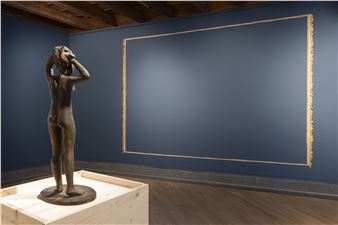Emilio IsgrГІ
CayГіn is pleased to present, in Madrid, the first exhibition of Emilio IsgrГІ (Barcellona of Sicily, 1937) at the gallery. The exhibition is introduced by a text from Italian art critic and art historian Bruno Cora.
Conceptual artist and painter – but also poet, writer, playwright and director – Emilio Isgrò is one of the most internationally known names of Italian art of the XXth and XXIst century.
Starting in the 1960s, Isgrò created one of the most revolutionary works of the so-called second avant-garde. By erasing texts in the form of encyclopedias, manuscripts, books and maps, Isgrò puts the practice of Cancellatura (Erasure) at the center of all his research, as “it is not mere negation, but rather affirmation of new meanings: it is the transformation of a negative sign into a positive action”.
Over the years, Isgrò’s work has been at the centre of several anthological exhibitions, as well as national and international collective expositions: he also participated in four editions of the Venice Biennale (1972, 1978, 1986, 1993), while in 1977 he won the first prize at the 14th São Paulo Biennale.
Numerous works are present in renowned national institutions, including the Uffizi Gallery in Florence, the collections of the Quirinale and the National Gallery of Modern and Contemporary Art in Rome, the Bocconi University and the Museum of XXthe Century in Milan, the Mart in Rovereto, as well as international collections such as the Centre George Pompidou in Paris, the MusГ©es Royaux des Beaux-Arts de Belgique in Brussels and the museums of Jerusalem and Tel Aviv.

Recommended for you
CayГіn is pleased to present, in Madrid, the first exhibition of Emilio IsgrГІ (Barcellona of Sicily, 1937) at the gallery. The exhibition is introduced by a text from Italian art critic and art historian Bruno Cora.
Conceptual artist and painter – but also poet, writer, playwright and director – Emilio Isgrò is one of the most internationally known names of Italian art of the XXth and XXIst century.
Starting in the 1960s, Isgrò created one of the most revolutionary works of the so-called second avant-garde. By erasing texts in the form of encyclopedias, manuscripts, books and maps, Isgrò puts the practice of Cancellatura (Erasure) at the center of all his research, as “it is not mere negation, but rather affirmation of new meanings: it is the transformation of a negative sign into a positive action”.
Over the years, Isgrò’s work has been at the centre of several anthological exhibitions, as well as national and international collective expositions: he also participated in four editions of the Venice Biennale (1972, 1978, 1986, 1993), while in 1977 he won the first prize at the 14th São Paulo Biennale.
Numerous works are present in renowned national institutions, including the Uffizi Gallery in Florence, the collections of the Quirinale and the National Gallery of Modern and Contemporary Art in Rome, the Bocconi University and the Museum of XXthe Century in Milan, the Mart in Rovereto, as well as international collections such as the Centre George Pompidou in Paris, the MusГ©es Royaux des Beaux-Arts de Belgique in Brussels and the museums of Jerusalem and Tel Aviv.












